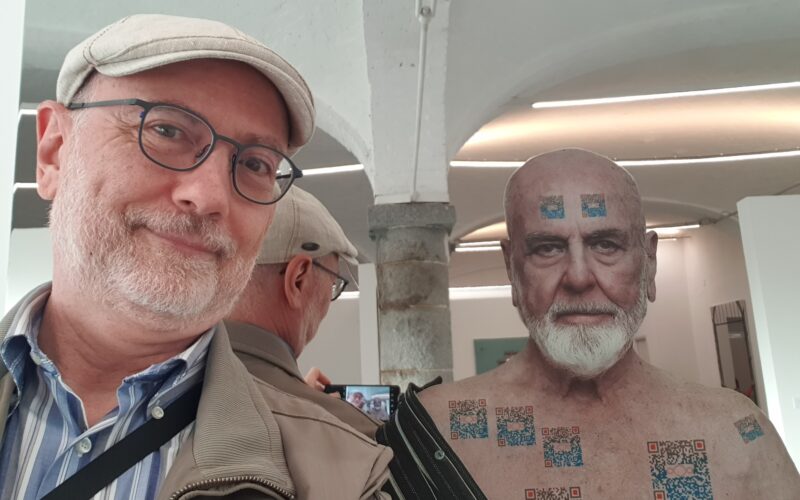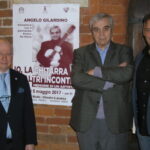In the quiet rooms of Cittadelladarte, where art and humanity merge in a perpetual enchantment, exists a work that reflects not only reality but also the observer. Michelangelo Pistoletto, a name embodying creativity and experimentation, has forged worlds within reflective surfaces, creating a realm of endless possibilities where the visitor becomes an integral part of the art.
When we stand before one of Pistoletto’s reflective works, the boundary between observer and artwork blurs, dissolves. In a modern, perhaps slightly irreverent impulse, we decide to take a selfie. But what happens in that moment? Is there a symbiosis, a meeting between two worlds, or is it a daring confrontation with the artist himself?
If we label this act as an artistic operation, then perhaps what emerges is an unexpected dialogue between the artist and the observer—a silent but eloquent conversation. The selfie becomes an appendage to the artwork, an added page to a book that will never have a definitive ending. It’s as if, through this act, the observer participates in the creative process, making the artwork a collaborative endeavor, a collage of aspirations, aesthetics, and gazes.
However, it might also be interpreted as a not-so-subconscious desire to measure oneself against the greatness of the artist. In this sense, the selfie becomes a point of comparison, a gauge of the distance between the artist and the observer, but also a celebration of the art itself, in its ability to evoke emotions and spark reflections.
So, if the selfie is an act of audacity, it’s also an act of humility. There’s the acknowledgment that art, in its boundless complexity, invites us to participate, to become characters in a drama that has neither beginning nor end but is constantly evolving.
In this symbiosis, the observer finds themselves navigating the calm and tumultuous waters of contemporary art, carrying with them a part of the artwork, a part that will eternally be theirs, yet shared with anyone else crossing the boundary between reality and reflection, inside and outside the mirror.
The selfie, therefore, is not merely a temporary fragment in a digital world; it’s a statement, a thought captured for eternity, whispering in the silence: “I was here, in this exact moment, and I became part of the artwork, part of the story.”
Whether Michelangelo Pistoletto would approve or not, one thing is certain: the moment our smartphone clicked, we were submerged, if only for an instant, in a parallel universe where art and life dance in an endless embrace.
And so, as we leave Cittadelladarte, one question hangs in the air, like a note in an unfinished symphony: who, between the artist and the observer, has truly completed the work? The answer, perhaps, is concealed in that fragile reflective surface, where reality and fiction blend into an enigma that only time may unveil.
If you enjoyed the journey through reflective surfaces and silent interrogations in the first article, I invite you to continue on the adventure. But this time, the journey becomes more personal. Instead of remaining external observers, we fully immerse ourselves in the experience, becoming part of the artwork ourselves.
We’ve explored the idea of artistic symbiosis and questioned the boundaries between the artist and the observer. Now, it’s time to take a closer look, to delve into the intricacies of our relationship with art and with ourselves.
Just as Pistoletto’s work reflects not only our image but also our emotions and thoughts, the next article represents an attempt to unveil those inner reflections, those sensations and emotions that only emerge when we find ourselves face to face, or rather “mirror to mirror,” with artistic greatness.
Prepare yourself for a new chapter in this dialogue with art, one that’s more intimate and perhaps, more revealing.
From the Exterior to the Intimate: An Unexpected Journey into the Art of Michelangelo Pistoletto
I walk through the rooms wrapped in the silence of Cittadelladarte, a place where art and humanity coexist like words in an unpublished poem. Then I find myself in front of a mirrored work by Michelangelo Pistoletto. I look at the work and see myself reflected in it, caught between reality and art. In an almost automatic act, I take out my smartphone and snap a selfie.
In that instant, I wonder: what have I just done? Is this an act of artistic creation or intrusion? Does Pistoletto’s work become a four-handed endeavor through symbiosis, or have I simply overlaid my desire to measure myself against the artist’s greatness?
If I choose to see my act as an artistic endeavor, then what emerges is a silent yet profound dialogue with the artist. The photograph becomes an extension of the work, an additional chapter to an ever-evolving story. Here, the mirrored work becomes a canvas on which to project not only the artist’s vision but my own as well. It’s as if, in that moment, Pistoletto and I are collaborating, blending our aesthetics and viewpoints into a complex and changing composition.
On the other hand, this could also be my unconscious desire to measure myself against the artist. In this case, the selfie becomes a way to test the limits of my role as observer and participant. It’s an exploration of the distance between me and the artist, but also a celebration of art itself, which has the power to bring forth such inquiries and provoke such emotional states.
In this context, my selfie is both audacious and humble. I recognize that art, in its sublime complexity, is not just something to observe from a distance but an experience to fully immerse oneself in. I become, even if only for a fragment of time, a co-creator of an artwork that is perpetually transforming.
And as I leave Cittadelladarte, a lingering question remains in the air, like a suspended melody: who, between me and Michelangelo Pistoletto, has truly completed the work? Perhaps the answer is hidden in the mirrored surface of the artwork itself, where reality and imagination blend into an enigma yet to be solved.












